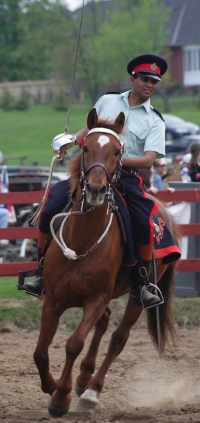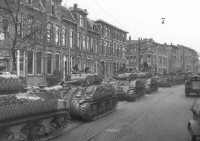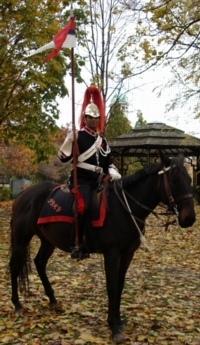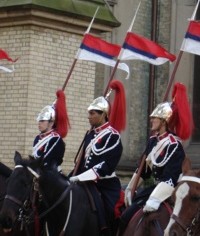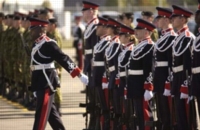 |
 |
| << return | ||
|
GGHG: The Governor General's Horse Guards |
||
|
|
||
|
Riding with the Governor General’s Horse Guards Cavalry Squadron has been one of my personal passions. The traditions of the cavalry are the source of the code, indeed the very word, of chivalry. As such, cavaliers symbolise the ideals of another era: the symbiotic relationship between man and beast; self-sacrifice; duty; gallantry; and personal honour. In essence, then, the cavalry is proudly anachronistic, incompatible with modern mores, and alien to the contemporary spirit of mechanised instant gratification. And did I mention cantering about, waving a musketeer's sword and lance, one tumble away from grotesque self-immolation? Really, what more could any man ask for? I stood down as an active member of the Cavalry Squadron when I moved to the Ottawa Valley. But no one ever really hangs up his spurs.
|
||
|
GGHG Mounted Swordsmanship |
Some Past Events
Fédération intenationale équestre (India)
Fédération intenationale équestre (Oman)
Queen's Park
Uxbridge Horsemen's Exposition
Toronto Police Memorial Service
State Visit by the Governor General
St James' Cathedral
|
|
|
GGHG Regiment at Arnhem 1945 |
Role of the Horse Guards Cavalry Squadron The Governor General’s Horse Guards, the Governor General’s Foot Guards, and the Canadian Grenadier Guards collectively form Canada’s Household Division, the branch of the Armed Forces notionally attached to the vice-regal household. The Horse Guards are Canada’s sole Household Cavalry regiment, while the Foot Guards and the Grenadier Guards are both Household Infantry regiments. The Horse Guards rode to war on horseback from its inception in 1810 until the First World War, when the regiment exchanged its horses for armoured vehicles. However, it maintains its ceremonial cavalry squadron to provide an equestrian guard on occasions of state and moment, and to celebrate the abiding traditions of military service. Today, the cavalry squadron is staffed by a combination of military and civilian volunteers. The squadron remains under the command and control of the regiment's commanding officer, but it is formally incorporated as a not-for-profit, to operate without drawing upon public funds.
|
|
|
GGHG Remembrance Day Parade |
Horse Guards Tack and Equipment The official 1907 British Cavalry Training manual famously held that, “It must be accepted as a principle that the rifle, effective as it is, can not replace the effect produced by the speed of the horse, the magnetism of the charge, and the terror of cold steel.” Hence, as late as the Battle of the Somme, château generals more enamoured with the imagined romance of past wars than familiar with the real carnage of modern combat stood ready to despatch wave after wave of young men in suicidal cavalry charges, pitting swords against machine-guns and lances against artillery. In this context, it is, perhaps, easy to regard the regalia carried by the Governor General’s Horse Guards Cavalry Squadron as extravagantly out of place in the modern world. However, these items are more than artefacts of another age, and far more than simple props of pageantry. Members of the Horse Guards have wielded the same steel swords and red plumed helmets for more than a century. Moreover, the pattern of these tokens were set by our antecedents in the old world Household Cavalry regiments well before Samuel de Champlain set foot in New France. Our regalia symbolise our fellowship with the cavaliers who came before us, and are the outward manifestations of a covenant of public service unimpaired by the march of time or the convulsions of fashion.
|
|
|
GGHG Cavalry Squadron at St James'
Cathedral |
Tent Pegging and Manoeuvres The classic cavalry squadron public performance is the musical ride. Executed by groups of four to thirty-two mounted cavaliers, the musical ride is a series of interlinked precision movements, choreographed to martial themes, which develop and display the courage of the horse and its mastery by the rider, the skills necessary for formation deployment of cavalry in battle. However, my favourite manoeuvres with the cavalry squadron are the tent pegging and skill-at-arms exercises. In the basic discipline, the rider spears a course of ground targets; this has its origins in the clash of horse versus elephant cavalry in the Indian Empire. In ring jousting, the rider threads his weapon through a course of small hoops suspended in mid-air; this mimics skewering mounted opponents in battle. Both exercises can employ either the sword or the lance and both may include jumping horses over obstacles. I have the honour to represent Canada at the International Tent Pegging Championships, when the Fédération internationale équestre brings together cavaliers from across the globe to vie for pride of place in a contest of horsemanship and edged weapons. My blog entries from India and from Oman record the respective results.
| |
|
GGHG Change of Commanding Officer |
Recruitment Anyone interested in learning more about the experience of volunteering with Governor General’s Horse Guards Cavalry Squadron from the perspective of a rider should feel free to contact me. Experienced riders may be inducted directly into the squadron. New riders may take lessons with the junior troop, and join the squadron once they become comfortable with essential equitation skills. The squadron itself is always eager to induct new members. The squadron's stables are in King City, 45km north-west of Toronto.
| |
|
|
|
CEO of the Mosaic Institute |
|
|
My work in international peacebuilding |
|
Testifying at Parliament |
|
|
My testimony on regulation of social media. |
|
United Nations |
|
|
My address in the UN General Assembly Chamber |
|
Toronto Star |
|
|
My article on how Canada should respond to Trump |
|
|
|
